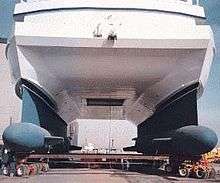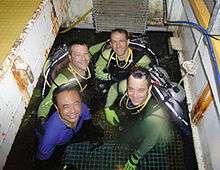Moon pool
 Underside of the Research Vessel Western Flyer, showing its moon pool between the two hulls. | |
| Uses | Protected access to the water for divers from a vessel, floating platform or underwater habitat |
|---|---|
A moon pool is a feature of marine drilling platforms, drillships and diving support vessels, some marine research and underwater exploration or research vessels, and underwater habitats, in which it is also known as a wet porch. It is an opening in the floor or base of the hull, platform, or chamber giving access to the water below, allowing technicians or researchers to lower tools and instruments into the sea. It provides shelter and protection so that even if the ship is in high seas or surrounded by ice, researchers can work in comfort rather than on a deck exposed to the elements. A moon pool also allows divers or small submersible craft to enter or leave the water easily and in a more protected environment.
Moon pools can be used in chambers below sea level, especially for the use of scuba divers, and their design requires more complex consideration of air and water pressure acting on the moon pool surface.
First use in oil drilling at sea
Moon pools originated in the oil drilling industry, which uses them in drilling at sea or in lakes, to pass drilling equipment into the water from a platform or drillship.[1] Drill pipes need to run vertically through the structure or hull and the moon pool provides the means to do this.
Types and associated structures
Above the waterline
In a drilling platform, the moon pool is usually above sea level, and is open to the air above and below. The research vessel Western Flyer (pictured) also has a moon pool above the waterline, which its SWATH (twin-hull) design allows. See part A of the diagram. The chamber above the moon pool is also connected to the open air via staircasewells and passages.
At the waterline
In a monohull ship the bottom of the hull is below sea level and the water rises inside the opening of the moon pool, so that from inside the hull, the moon pool looks like a swimming pool in the floor. Water will not enter the hull and sink the ship provided the sides of the moon pool extend up inside the hull well above the waterline, as shown in part B of the diagram. This kind of moon pool is also open to the air above the ship. Doors would be used to close the bottom of the moon pool when the ship is moving, or in rough weather. The sides of the moon pool are quite deep as they need to be greater than the draft of the ship by a margin of safety.
Below the waterline
It is possible to have a moon pool below the waterline and to keep water out of the chamber above it, if the chamber is airtight rather than open to the atmosphere above in any way. This arrangement is shown in part C of the diagram. Air pressure inside the chamber prevents water rising in the moon pool up to sea level. To keep the chamber airtight, access from the chamber to the rest of the ship is via an airlock with airtight doors. The design of the ship and its safety systems need to take into account the possibility of an air leak or catastrophic failure of the airlock.
In this arrangement the sides of the moon pool can be fairly shallow, and it can be used in a deep-draft ship without wasting space.
In underwater habitats

Very deep moon pools are used in underwater habitats—submerged chambers used by divers engaged in underwater research, exploration, marine salvage, and recreation. In this case, shown in part D of the diagram, there is no dry access between the chamber and the sea surface, and the moon pool is the only entry or exit to the chamber. Submerged chambers provide dry areas for work and rest without the need to ascend to the surface.[2] This kind of submerged chamber uses the same principles as the diving bell, except they are fixed to the seafloor, and may be called a wet porch, wet room, or wet bell. Sometimes the term moon pool is used to mean the complete chamber, not just the opening in the bottom and the air–water interface.
The alternative to a moon pool in an underwater habitat is the lock-out chamber, which is essentially like a fixed submarine, maintaining internal air pressures lower than ambient sea pressure down to 1 atmosphere, with an airlock to enable entry and exit underwater. Underwater habitats may have connected chambers with moon pools and lock-out chambers.
Examples of underwater habitats with moon pools
- SEALAB II (US Navy)[3]
- Aquarius (laboratory), Florida has a moon pool in one of its three chambers, called the wet porch.
- Jules' Undersea Lodge, Key Largo, Florida. Page includes photo of moon pool.
Pressure considerations in below-waterline moon pools
Airtight chambers with below-waterline moon pools contain air that is pressurised by the weight of the sea above it, which tries to force water up into the chamber through the moon pool. The air is compressed by the water until its pressure equals that of the water at the surface of the pool, and a state of hydrostatic equilibrium is reached. Air pressure in the chamber can be calculated from the depth d of the moon pool surface below the waterline using formulas for hydrostatic pressure. Note that it is not necessary to pressurise the air in the chamber with a compressor or to keep it pressurised unless there is a leak, or a need to replenish air breathed.
Divers use a 'rule of thumb' that every 10 m depth of water adds about 1 atmosphere of pressure (14.7 PSI or about 1 kilogram-force per square centimetre). Using this rule, if the depth d in diagram part C is 6 m (about 20 feet), the pressure in the chamber is
- atmospheric pressure + 0.6 atmospheres = 1.6 atmospheres.
If the depth d in part D is 50 m (about 160 feet), the pressure is 6 atmospheres.
These principles are the same as those used in diving and diving bells for working out the pressure of the air inhaled by the diver. The same medical and safety principles with regard to air supply, oxygen and carbon dioxide content of the air, nitrogen narcosis, and the bends applies to airtight chambers with below-waterline moon pools. If the moon pool is more than 30 m below the waterline, the possibility of nitrogen narcosis becomes a factor, and methods of decompression may need to be used in exiting through the airlock from the chamber into any other part of the ship or structure which are at normal atmospheric pressure, as well as in ascending to the surface via the water.
Note that submarines and small submersible craft generally use normal atmospheric pressure and the hulls have to be made immensely strong to resist being crushed by water pressure at depth. Conversely, the huge difference in pressure with submerged moon pools presents problems for divers entering and exiting from such vessels.
Submerged chambers with moon pools do not have to be constructed to prevent crushing, since they do in fact contain air at a higher pressure than the water over their surface except for the bottom, where it is equal. Containing air at the same pressure as the surrounding water is also an advantage to divers who can enter a deep chamber from the water without undergoing decompression.
Leaks in submerged moon-pool chambers
If a submerged chamber with a moon pool is holed in the floor, there is no trade to the moon pool water level or the air pressure inside the chamber—it has no effect. If such a chamber is holed in its side or roof, many might predict that water would squirt or gush in through the hole and flood the chamber, as it would in a submarine. In fact this scenario is completely incorrect: instead air will leak out of the hole into the water and prevent water coming in, even if the hole is very large, and the surface level of the moon pool will rise up into the chamber until it reaches the top of the hole, at which point it will stop rising, air will stop escaping, and an air space will be left above the hole.
This is because the air in the chamber has a pressure higher than the water on the outside of the hole. The air pressure in the chamber equals the water pressure at the surface of the moon pool; the water pressure at the hole is less than this by an amount determined by the height difference between hole and moon pool surface. If the hole is 2.4 m higher than the moon pool surface, using the divers' rule of thumb, the air pressure will be 0.24 atm (about 3.5 PSI) higher than the water on the outside of the hole. This figure does not vary with the depth of the chamber below sea level. Compare the situation with a submarine having an internal air pressure of 1 atm. At a hole in its hull 20 m below sea level, the seawater will have a pressure 2 atm (30 PSI) higher than the air and will come through the hole as a jet.
See also
References
- ↑ Oilfield Glossary: "Moon Pool'. Schlumberger website, retrieved 17 July 2007.
- ↑ Gregory Stone: "Deep Science". National Geographic Online Extra (Sept 2003). Retrieved 29 July 2007.
- ↑ US Navy: Naval Undersea Museum SEALAB page, retrieved 1 August 2007.
